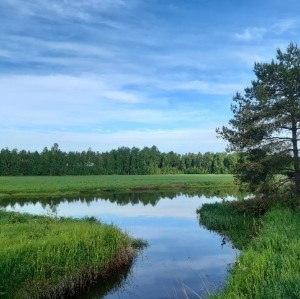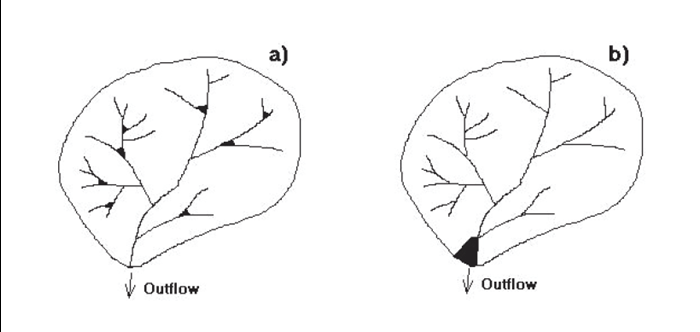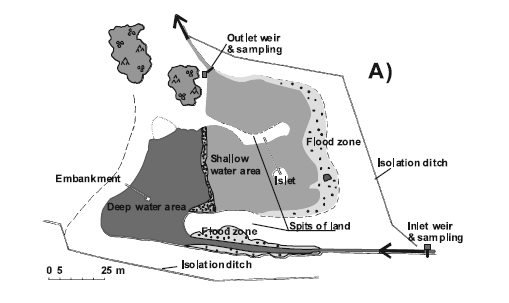Constructed wetlands

Constructed wetlands (CWs) reduce agricultural water pollution and complement the water protection measures made in the fields. Locally, CWs can significantly improve the status of waters, as they prevent the transport of nutrients and solids into the recipient waterbodies.
CWs also store water and thus decrease the risk of flooding in the downstream areas. Moreover, farmers can use the stored water for irrigation and thereby recycle the nutrients back to the fields.
Birds, game, fish, crabs and many other animals thrive in CWs. Well-planned and -built CWs also bring pleasure to the eye and enliven rural landscapes.
Localisation and implementation
In order to be eligible for agri-environmental subsidy in Finland, CWs must together cover at least 0.5% of the catchment, of which at least 10% must be agricultural fields. The higher the sediment and nutrient concentrations of the inflow waters are, the more efficiently the CWs work.
CWs must be established primarily by damming, but in practice it is always necessary to carry out some excavation work, e.g. to create the deep parts.
Effects, duration and maintenance
In terms of the retention of solid material, the positive effects of CWs are (a while after the construction) immediate, whereas for dissolved nutrients it takes some 5 years until the retentions are substantial. For nitrogen (N), the retention capacity of a CW is infinite (denitrification). For phosphorus (P), the retention capacity of CW soil (adsorption) is limited. Nevertheless, biological P (and N) removal and settling of P-rich soil particles will continue. This, however requires maintenance of CWs by removing the settled sediment and mowing of overgrown vegetation in every, say, 5–10 years.

Constructed wetlands - extended description
Description
Constructed wetlands (CWs) reduce agricultural water pollution and complement the water protection measures made in the fields. Locally, CWs can significantly improve the status of waters, as they reduce the transport of nutrients and solids into the recipient waterbodies. In a Finnish study based on continuous, automatic monitoring lasting for 7 years (Koskiaho & Puustinen 2019), on average 70% of total suspended solids (TSS), 60% of total phosphorus (Ptot) and 50% of total nitrogen (Ntot) were retained in a well-planned and dimensioned CW. In the same study another CW with smaller CW-to-catchment area ratio and lower share of agricultural land in its upstream catchment only retained ca. 10% of the input loadings.
CWs also store water and thus decrease the risk of flooding in the downstream areas. Moreover, farmers can use the stored water for irrigation and thereby recycle the nutrients back to the fields. Birds, game, fish, crabs and many other animals thrive in CWs. For example, Wiegleb et al. (2017) regarded CWs as an important additional component of biodiversity protection. Moreover, Begosh et al. (2020) highlighted the importance of wetlands as habitats for pollinating insects. Well-planned and -built CWs also bring pleasure to the eye and enliven rural landscapes.
Localisation and implementation
In order to be eligible for agri-environmental subsidy in Finland, CWs must together cover at least 0.5% of the catchment, of which at least 10% must be agricultural fields. The higher the sediment and nutrient concentrations of the inflow waters are, the more efficiently the CWs work. Therefore, it is in most cases advisable to place CWs as close as possible to the sources of load.
Roughly speaking, there are two different approaches, or strategies, how to place wetlands in a catchment (Fig. 1). The advantages of the strategy a) are that i) an adequate CW-to-watershed area ratio is more readily available and ii) that the input waters are less diluted than in strategy b). Meanwhile in strategy b) the advantage is that entire loading from the catchment will be treated in the CW. Tournebize et al. (2017) recommended the strategy a) for the removal of pesticides and strategy b) for nitrate. The authors mentioned that the first flows following pesticide applications are the most highly concentrated, which favors the proximity of a CW to the source of loading. Similar deduction is likely to hold good as well to TSS and Ptot, which also show flashy behavior with rapidly increasing and decreasing concentrations during flood events. Instead, for nitrate the concentrations do not vary so much in different spatial scales. Therefore, if nitrate retention is the main target, and if there is large enough area available, the CW can be well established at the outlet of an agricultural catchment, like in alternative b) in Fig. 1.
In terms of construction techniques, CWs should be established primarily by damming to minimize construction costs. However, in practice it is always necessary to carry out some excavation work, e.g. to create the deep parts. Generally, CWs have proved to be cost-effective alternatives in water protection (Hjerppe & Väisänen 2015, Gachango et al. 2015).

Effects, duration and maintenance
Like noted in the Description -section, CWs can be at best very effective in TSS and nutrient retention. In terms of the retention of solid material, the positive effects of CWs are (a while after the construction) immediate, whereas for dissolved nutrients it may take some 5 years until the retentions are substantial (Koskiaho et al. 2003, Koskiaho & Puustinen 2019).
For nitrogen (N), the retention capacity of a CW is infinite (denitrification, see e.g. Xue et al. 1999), but for phosphorus (P), the retention capacity of CW soil (adsorption, see e.g. Richardson 1985) is limited. Nevertheless, biological P (and N) removal and settling of P-rich soil particles will continue. However, in order to remain effective, this requires maintenance of CWs by removing the settled sediment and mowing of overgrown vegetation in every, say, 5 years (Puustinen et al. 2007).
Constructed wetlands - links to resources
Pamphlets, reports, videos and websites
Puustinen, M., Koskiaho, J., Jormola, J, Järvenpää, L., Karhunen, A., Mikkola-Roos, M., Pitkänen, J., Riihimäki, J., Svensberg, M & Vikberg, P. 2007. Maatalouden monivaikutteisten kosteikkojen suunnittelu ja mitoitus. (Multipurpose wetlands for agricultural water protection – guidelines of wetland planning and dimensioning). Finnish Environment Institute (SYKE). Helsinki. 77 p. (In Finnish with English abstract). Link
Video - Constructed wetland in Latvia (Interreg Europe AQUARES)
Wikipedia - Wetland
Scientific papers
Begosh, A., Smith, L.M., Park, C.N., Mcmurry, S.T & Lagrange, T.G. 2020. Effects of Wetland Presence and Upland Land Use on Wild Hymenopteran and Dipteran Pollinators in the Rainwater Basin of Nebraska, USA. Wetlands 40: 1017–1031. DOI
Koskiaho, J. & Puustinen, M. 2019. Suspended solids and nutrient retention in two constructed wetlands as determined from continuous data recorded with sensors. Ecological Engineering 137: 65–75. DOI
Tournebize, J., Chaumont, C. Mander, Ü. 2017. Implications for constructed wetlands to mitigate nitrate and pesticide pollution in agricultural drained watersheds. Ecological Engineering 103: 415–425. DOI
Wiegleb, G., Dahms, H-U., Byeon, W.I. & Choi, G. 2017. To What Extent Can Constructed Wetlands Enhance Biodiversity? International Journal of Environmental Science and Development 8(8): 561–569. DOI
Gachango, F.G., Pedersen, S.M. & Kjaergaard, C. 2015. Cost-Effectiveness Analysis of Surface Flow Constructed Wetlands (SFCW) for Nutrient Reduction in Drainage Discharge from Agricultural Fields in Denmark. Environmental Management 56: 1478–1486. DOI
Hjerppe, T. & Väisänen, S. 2015. A practical tool for selecting cost-effective combinations of phosphorus loading mitigation measures in Finnish catchments. International Journal of River Basin Management 13(3): 363-376. DOI
Koskiaho, J., Ekholm, P., Räty, M., Riihimäki, J. & Puustinen, M. 2003. Retaining agricultural nutrients in constructed wetlands - experiences under boreal conditions. Ecological Engineering 20(1): 89–103. DOI
Xue, Y., Kovacic, D.A., David, M.B., Gentry, L.E., Mulvaney, R.L. & Lindau, C.W., 1999. In situ measurements of denitrification in constructed wetlands. Journal of Environmental Quality 28: 263–269. DOI
Richardson, C.J. 1985. Mechanisms Controlling Phosphorus Retention Capacity in Freshwater Wetlands. Science 228(4706): 1424–1427. DOI
Author and contact:
Jari Koskiaho, Finnish Environment Institute (SYKE), Finland. e-mail

